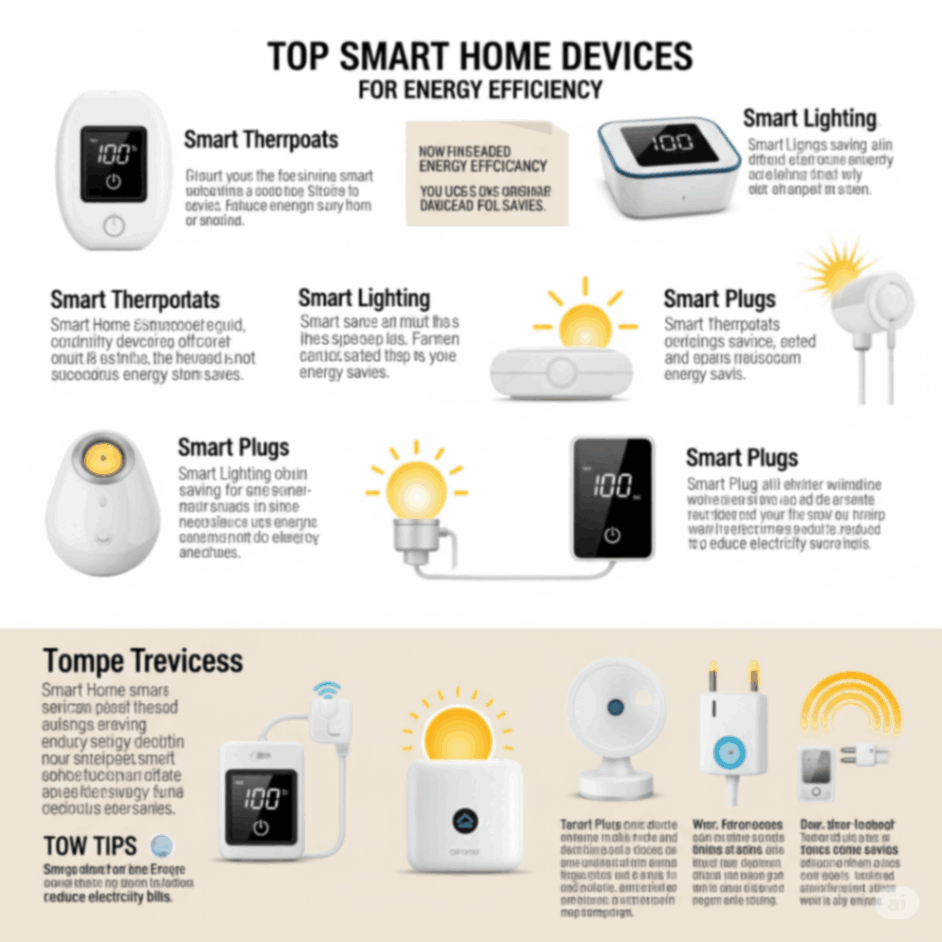Introduction
As the demand for energy-efficient solutions continues to grow, many homeowners are turning to smart home devices to reduce energy consumption and lower utility bills. With advancements in technology, it’s now easier than ever to optimize energy use through automated systems that control lighting, heating, cooling, and other household functions.
In this article, we will explore some of the top smart home devices for energy efficiency. We will highlight key features, benefits, and how these devices can help you save money while making your home more eco-friendly. Whether you’re looking to install smart thermostats, energy-efficient lighting, or smart appliances, there’s a range of solutions available to fit your needs.
Why Focus on Energy Efficiency in Smart Homes?
Energy efficiency is not just about saving money; it’s also about contributing to a sustainable future. According to the International Energy Agency (IEA), energy-efficient technologies in homes and buildings have a significant role to play in reducing global carbon emissions.
By adopting smart home devices that help manage energy use, you can:
-
Reduce Energy Costs: Smart devices automate energy usage, ensuring that you’re only consuming power when necessary.
-
Lower Carbon Footprint: Efficient energy usage helps reduce the environmental impact of your household.
-
Enhance Comfort and Convenience: Many smart home devices offer features that adapt to your lifestyle, providing both efficiency and comfort.
Top Smart Home Devices for Energy Efficiency
1. Smart Thermostats
Smart thermostats are one of the most popular energy-efficient devices for homes. They allow you to control your home’s heating and cooling systems remotely, optimizing energy use throughout the day. These devices learn your preferences and adjust settings automatically based on your schedule, ensuring comfort without wasting energy.
Key Benefits:
-
Remote Control: Adjust your thermostat from anywhere via a smartphone app.
-
Energy Savings: By optimizing temperature settings based on your habits, smart thermostats can save homeowners up to 10-15% on heating and cooling costs annually.
-
Learning Capabilities: Some models, like the Nest Learning Thermostat, can learn your schedule and automatically adjust the temperature, reducing unnecessary energy consumption.
| Smart Thermostat Model | Key Feature | Energy Efficiency Benefit |
|---|---|---|
| Nest Learning Thermostat | Learns your schedule and adjusts the temperature accordingly. | Saves up to 15% on heating and cooling costs. |
| Ecobee SmartThermostat | Includes a room sensor to optimize temperature in different rooms. | Reduces energy costs by optimizing heating/cooling efficiency. |
| Honeywell Home T9 | Smart thermostat with geofencing technology for remote control. | Cuts energy use by automatically adjusting temperature based on occupancy. |
Lighting can account for a significant portion of your household’s energy consumption. Smart lighting systems, such as Philips Hue and LIFX, enable you to control the brightness and color of your lights, set schedules, and automate lighting based on occupancy. These devices help minimize energy waste and can create a more comfortable, personalized environment in your home.
Key Benefits:
-
Remote Control: Turn lights on and off, dim them, or change their color from your smartphone, even when you’re not home.
-
Motion Sensors: Some systems include motion sensors that automatically turn off lights when no one is present, saving energy.
-
Energy-Efficient Bulbs: Many smart lighting systems use LED bulbs, which consume far less energy than traditional incandescent bulbs.
| Smart Lighting Model | Key Feature | Energy Efficiency Benefit |
|---|---|---|
| Philips Hue | Customizable, app-controlled lighting system. | Reduces energy consumption with dimmable LEDs and automation. |
| LIFX | Wi-Fi-enabled bulbs with a wide color range and scheduling features. | LED bulbs use up to 80% less energy than incandescent bulbs. |
| Wyze Bulb | Affordable smart bulbs with app control and scheduling. | Automatically adjusts brightness based on time of day. |
Smart plugs and power strips are simple but highly effective devices for reducing energy consumption. These devices allow you to control electronic devices remotely and set schedules for when they should be powered on or off.
Key Benefits:
-
Remote Control: Turn appliances on or off using a smartphone app, even when you’re away from home.
-
Energy Monitoring: Some smart plugs, like TP-Link Kasa Smart Plug, track the energy usage of connected devices, providing insights into where you can save.
-
Scheduling: Set schedules to turn off devices when not in use, preventing “phantom” energy use from electronics that are plugged in but not actively being used.
| Smart Plug Model | Key Feature | Energy Efficiency Benefit |
|---|---|---|
| TP-Link Kasa Smart Plug | Energy monitoring, remote control via app. | Cuts energy waste by allowing users to track and schedule appliance use. |
| Wemo Mini Smart Plug | Compact plug with voice control and scheduling. | Reduces energy waste by scheduling devices to turn off automatically. |
| Eve Energy Smart Plug | Tracks energy consumption and provides insights. | Helps monitor and reduce energy usage by providing detailed data on connected devices. |
Smart appliances, including refrigerators, washing machines, and ovens, are becoming increasingly popular in energy-efficient homes. These appliances can be controlled remotely, schedule tasks, and optimize energy use, making them more efficient than their traditional counterparts.
Key Benefits:
-
Energy Monitoring: Many smart appliances, such as Samsung’s Smart Fridge, allow you to monitor their energy consumption and adjust settings to reduce usage.
-
Remote Control: Start your washing machine or oven remotely, or set your fridge to energy-saving mode when you’re away.
-
Efficiency Optimizations: Smart dishwashers and washing machines can automatically adjust water and energy usage based on the load size, saving both water and electricity.
| Smart Appliance Model | Key Feature | Energy Efficiency Benefit |
|---|---|---|
| Samsung Smart Fridge | Monitors energy consumption and can be remotely controlled. | Saves energy by adjusting cooling based on usage patterns. |
| LG Smart Washer | Schedules wash cycles for optimal energy use. | Reduces energy and water consumption by optimizing cycles. |
| GE Profile Smart Oven | Can be controlled remotely for preheating and cooking schedules. | Optimizes cooking time and temperature to reduce energy use. |
Smart fans can be a great addition to your energy-efficient home, providing cooling without relying heavily on air conditioning. Smart fans, such as the Big Ass Fans Haiku, use advanced technology to adjust fan speed based on room temperature, ensuring comfort while using minimal energy.
Key Benefits:
-
Energy Savings: Smart fans consume less electricity compared to air conditioning systems and can be scheduled to turn on or off automatically.
-
Quiet Operation: Many smart fans operate quietly, allowing for a comfortable, undisturbed environment.
-
Room Temperature Control: Some models, like Haiku Fans, can adjust their speed based on the temperature of the room to optimize cooling.
| Smart Fan Model | Key Feature | Energy Efficiency Benefit |
|---|---|---|
| Big Ass Fans Haiku | Adjustable fan speed and temperature control. | Reduces energy usage compared to traditional air conditioning. |
| Dyson Pure Cool | An air purifying fan that adjusts based on temperature and air quality. | Provides cooling and purifying in one, reducing the need for multiple devices. |
To make the most of your energy-efficient smart home devices, consider the following tips:
-
Create Routines: Use your smart devices to create routines that automatically adjust settings based on the time of day or your schedule.
-
Integrate with Voice Assistants: Connect your smart home devices to voice assistants like Amazon Alexa or Google Assistant for hands-free control.
-
Monitor Energy Consumption: Use apps to track energy consumption and identify areas where you can make further improvements.
| Tip | Action |
|---|---|
| Create Smart Routines | Automate temperature control, lighting, and appliance use based on your daily routine. |
| Voice Assistant Integration | Connect your devices to Alexa or Google Assistant for easy voice control. |
| Monitor Energy Consumption | Use apps or built-in monitoring features to track and reduce energy usage. |
1. How do smart home devices help with energy efficiency?
Smart home devices allow you to automate and control your home’s energy use more effectively. For example, smart thermostats adjust the temperature based on your schedule, and smart lights automatically turn off when no one is in the room.
2. Are smart home devices expensive?
While some smart home devices can be costly, many offer long-term savings through reduced energy consumption. Over time, the initial investment can be offset by lower utility bills.
3. Can I control my smart home devices remotely?
Yes, most smart home devices can be controlled remotely through smartphone apps, allowing you to adjust settings whether you’re at home or on the go.
4. How can I make my home fully energy-efficient with smart devices?
By incorporating a combination of smart thermostats, lighting systems, appliances, and power strips, you can significantly reduce energy consumption while enhancing comfort and convenience.
Conclusion
Smart home devices for energy efficiency offer a compelling solution to help homeowners reduce their carbon footprint and lower utility bills. From smart thermostats and lighting to energy-efficient appliances and smart plugs, these devices are changing the way we interact with our homes. By investing in the right technology, you can create a more sustainable living environment and enjoy the long-term benefits of energy savings.
To explore more about creating a smart home or learn how energy efficiency can transform your household, visit Derektime for additional insights and resources.
By integrating energy-efficient smart home devices into your daily life, you’ll not only save money but also contribute to a more sustainable future. As technology continues to evolve, the possibilities for smarter, greener homes will only expand.

